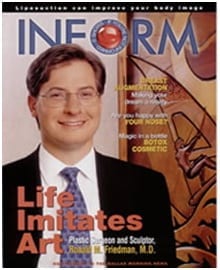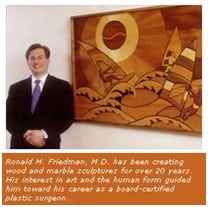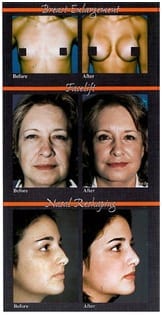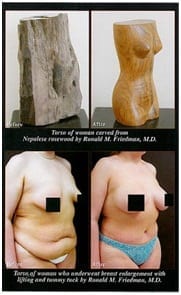Posted July 02, 2018 in
Inform/The Dallas Morning News, June 2002
An Interview with Plastic Surgeon and Sculptor, Ronald M. Friedman, M.D.
 Prior to entering private practice in 1996, Dr. Friedman served as Chief of Plastic Surgery at Parkland Memorial Hospital and Assistant Professor of Plastic Surgery at the University of Texas Southwestern Medical Center in Dallas. After graduating with Honors from Northwestern University Medical School in Chicago, he completed his general surgery and plastic surgery training at the University of Texas Southwestern Medical Center. Dr. Friedman has numerous journal and textbook publications, national presentations, and radio and television interview to his credit. He has written invited commentaries for the Journal of Plastic and Reconstructive Surgery and Plastic Surgery Outlook. He has been the recipient of honors and awards from the American Society for Aesthetic Plastic Sur.gery, the American Society of Plastic Surgeons, and the Texas Society of Plastic Surgeons. He is Board Certified in Plastic Surgery.
Prior to entering private practice in 1996, Dr. Friedman served as Chief of Plastic Surgery at Parkland Memorial Hospital and Assistant Professor of Plastic Surgery at the University of Texas Southwestern Medical Center in Dallas. After graduating with Honors from Northwestern University Medical School in Chicago, he completed his general surgery and plastic surgery training at the University of Texas Southwestern Medical Center. Dr. Friedman has numerous journal and textbook publications, national presentations, and radio and television interview to his credit. He has written invited commentaries for the Journal of Plastic and Reconstructive Surgery and Plastic Surgery Outlook. He has been the recipient of honors and awards from the American Society for Aesthetic Plastic Sur.gery, the American Society of Plastic Surgeons, and the Texas Society of Plastic Surgeons. He is Board Certified in Plastic Surgery.
What got you interested in Plastic Surgery?
During high school, I watched a television program about Burt Brent, M.D., a famous plastic surgeon at Stanford who reconstructed ears by carving rib cartilage. I had been carving wood and marble for a few years and was intrigued by the idea of using art to help people. I went out to visit Dr. Brent for a few days. As I watched him work, I said to myself, “I bet I can do that.”
 Does your experience as an artist help you as a plastic surgeon?
Does your experience as an artist help you as a plastic surgeon?
I believe that the traits that make a good artist – creativity, patience, and persistence – also make a good plastic surgeon. Having an eye for proportion and detail is helpful both in the workshop and the operating room.
What cosmetic procedures do you perform?
The most frequently performed surgical procedures in my practice are breast enhancement (enlargement, reduction, and lifting), body contouring (liposuction, mini and full tummy tuck), and facial surgery (facelift, eyelid lift, and nasal reshaping). We also offer non-surgical procedures, such as microdermabrasion, Botox injections, permanent makeup, and skin care.
Do you also do reconstructive surgery? And why?
Cosmetic surgery comprises the majority of my practice. But I continue to perform reconstruction for women with breast cancer, facial reconstruction, hand surgery (in which I completed a one-year fellowship), and skin tumor removal and reconstruction. I think that these are important services that plastic surgeons provide for our community. I also believe that doing reconstructive procedures, especially challenging tumors and trauma, helps me to refine my skill in performing cosmetic surgery.
You are obviously very busy. What attracts patients to your practice?
My staff and I go out of our way to provide a relaxed and friendly environment that puts people at ease. We take the time to thoroughly address every concern and question, never rushing patients through the consultation. We have extensive before and after photographs, and we are always happy to provide references for patients considering cosmetic surgery. Most of our patients are referred to us by physicians, nurses, and other patients.
How involved are you in the day-to-day care of your cosmetic surgery patients?
Although I have a very capable staff, I recognize that people are placing their trust in me to provide their care. In many practices, the consultation is done primarily by a cosmetic surgery coordinator, closure of surgical incisions is done by a nurse or physician’s assistant, and postoperative visits are done by a nurse or medical assistant. In contrast, I remain committed to conducting every consultation, performing the entirety of every operation, and seeing cosmetic surgery patients at every postoperative visit. No matter how busy I am, I do not delegate my responsibility to provide patient care.
 Where do you perform your surgeries?
Where do you perform your surgeries?
Most procedures are performed at the West Plano Plastic Surgery Center, which adjoins my office on the campus of Presbyterian Hospital of Plano. The Center offers a high level of privacy and personalized attention. More important, the Center is nationally accredited by the American Association for the Accreditation of Ambulatory Surgical Facilities. We exclusively use physician anesthesiologists (rather than nurse anesthetists), as I believe that their specialized training enhances patient comfort and safety. To provide further safety, our Nursing Director used to be the Director of Nursing for the Critical Care Unit at Medical Center of Plano. The center has only one operating suite, as I do not believe that I can safely operate on two patients simultaneously.
For patients requiring an overnight stay, I am on the surgical staff at Presbyterian Hospital of Plano, Medical Center of Plano, Trinity Medical Center in Carrollton, and Medical Center of Lewisville.
We understand that breast enlargement is your most frequently performed surgery. How are your results?
Dallas is probably the U.S. capital for breast enlargement. As a result, there is no shortage of capable surgeons. Recent data submitted to the FDA by breast implant manufacturers reveals that 16 percent of women undergoing breast enlargement required further surgery within three years. I have been fortunate to have a three-year re-operation rate under 3 percent. Like every other plastic surgeon, I have and will continue to have complications. But this low rate is certainly reassuring.
Why do you think your complication rate is so low?
It’s probably a combination of good luck and good technique. Rather than “bluntly dissecting” the breast tissue, I take the time to cauterize the tissues as they are being elevated. This reduces bleeding, virtually eliminates bruising, and makes compression bras and ACE wraps unnecessary. In addition, I add a step to the procedure by placing implant “sizers” prior to placement of the actual implants. This eliminates guesswork by allowing me to evaluate and adjust implant size and implant pocket dimensions prior to actual implant placement.
 Are there any unusual procedures that you perform?
Are there any unusual procedures that you perform?
For women who are concerned about loss of fullness and drooping of the breasts, most surgeons use relatively extensive incision to place implants and lift the breasts. I perform a large number of limited-incision enlargements with lifts. There is a circular incision around the areola (the pigmented skin about the nipple). There are generally no other incisions. In patients who experience aging of the lower eyelid, I lift the entire lower eyelid by mobilizing muscles and reattaching them higher on the bone around the eye. This often provides greater improvement than traditional lower eyelids lifts. I often perform a truly minimal incision mini tummy tuck for women with mild lower abdominal laxity. The incision is sometimes under two inches. I’m also the only cosmetic surgeon I know who performs certain unusual reconstructive procedures, such as limb reattachment for traumatic amputations.
What advice can you offer patients who are considering cosmetic surgery?
Shop around. Make sure that your surgeon is certified by the American Board of Plastic Surgery. Ask him how frequently he performs the surgery, where he performs it, and whether the facility is accredited. Ask to view before-and-after photos and to speak with other patients who have had the procedure that you are seeking. Make sure that he takes the time to personally answer your questions and address your concerns. If he is in a hurry before surgery, will he be in a hurry during surgery? Above all, make sure that you feel comfortable with the surgeon and his office staff–you’ll be spending a lot of time with them.
We understand that you are the Former Chief of Plastic Surgery at Parkland Memorial Hospital in Dallas. Are you still involved in academic medicine?
I remain very interested in academic plastic surgery. I have had the opportunity to serve as a Clinical Instructor for the American Society of Plastic Surgeons since 1996. I am also Candidate Liaison for the American Society for Aesthetic Plastic Surgery. Within the past several months, I have been issued a patient for a new breast implant filling material and have co-authored three chapters of the recently published text, The Dallas Rhinoplasty: Nasal Surgery by the Masters.
One last question. Did you really make those windsurfers (on the magazine cover)?
Yes, I really did. I had to carve about 300 pieces of wood, ranging from standards like mahogany and maple to exotic woods like rosadio and lignum vitae. It took over 100 hours to make. And I loved every minute of it.